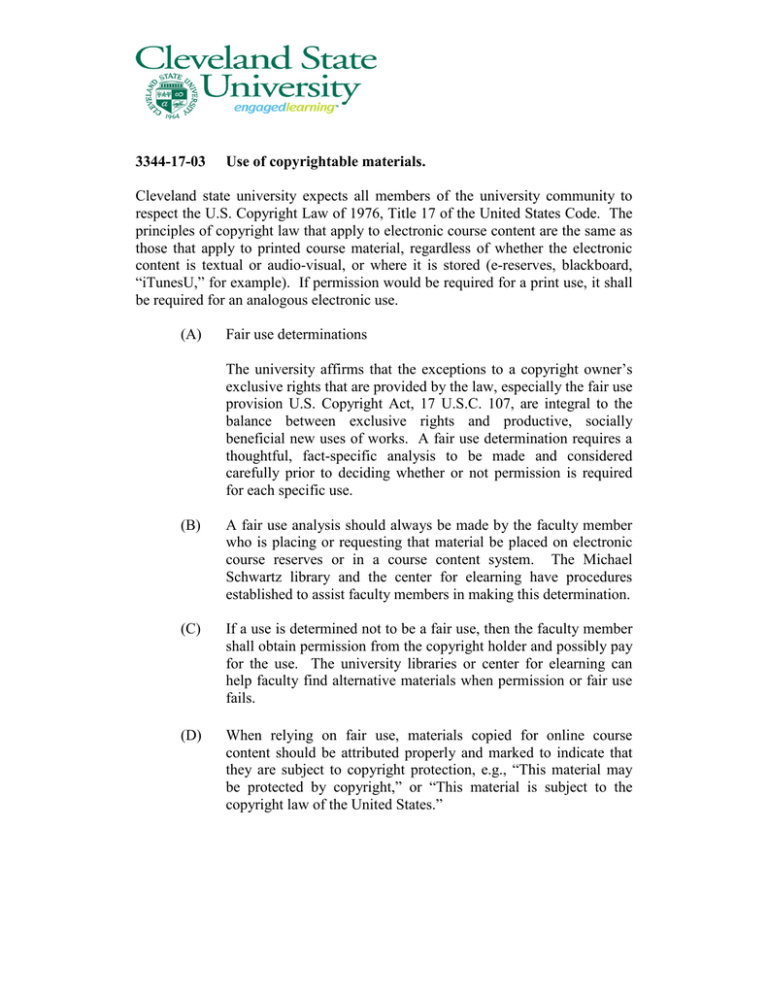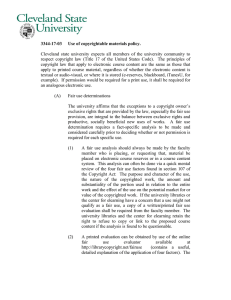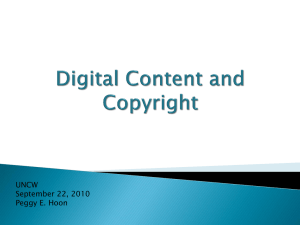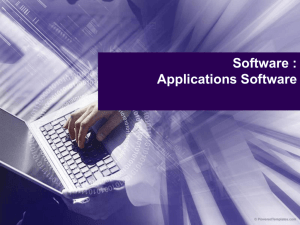Cleveland state university expects all members of the university community... respect the U.S. Copyright Law of 1976, Title 17 of... 3344-17-03
advertisement

3344-17-03 Use of copyrightable materials. Cleveland state university expects all members of the university community to respect the U.S. Copyright Law of 1976, Title 17 of the United States Code. The principles of copyright law that apply to electronic course content are the same as those that apply to printed course material, regardless of whether the electronic content is textual or audio-visual, or where it is stored (e-reserves, blackboard, “iTunesU,” for example). If permission would be required for a print use, it shall be required for an analogous electronic use. (A) Fair use determinations The university affirms that the exceptions to a copyright owner’s exclusive rights that are provided by the law, especially the fair use provision U.S. Copyright Act, 17 U.S.C. 107, are integral to the balance between exclusive rights and productive, socially beneficial new uses of works. A fair use determination requires a thoughtful, fact-specific analysis to be made and considered carefully prior to deciding whether or not permission is required for each specific use. (B) A fair use analysis should always be made by the faculty member who is placing or requesting that material be placed on electronic course reserves or in a course content system. The Michael Schwartz library and the center for elearning have procedures established to assist faculty members in making this determination. (C) If a use is determined not to be a fair use, then the faculty member shall obtain permission from the copyright holder and possibly pay for the use. The university libraries or center for elearning can help faculty find alternative materials when permission or fair use fails. (D) When relying on fair use, materials copied for online course content should be attributed properly and marked to indicate that they are subject to copyright protection, e.g., “This material may be protected by copyright,” or “This material is subject to the copyright law of the United States.” 3344-17-03 2 (E) Copyright protected course content should be kept behind password/authentication barriers so only students enrolled in the class can access it. (F) Materials should remain available only for a limited time, usually no longer than necessary for a particular class use, after which they shall be removed. These are services that are provided by the Michael Schwartz library, the Cleveland-Marshall college of law library, and the center for elearning. (G) Linking to copyrighted materials The digital age has made potential course content available in a wide variety of ways, and faculty can often choose amongst several formats to make reading, viewing, and listening materials available to students. If it is possible to link to material that is either publicly available on the web or available to the Cleveland state university community through a database licensed (including the right to link to articles for use in course content systems) by the Michael Schwartz library, the Cleveland-Marshall college of law library, the center for elearning, or “OhioLINK,” further permission is not needed to use that material. (H) Making copies of copyrighted materials (1) (2) When it is necessary to make a copy of the material, rather than simply linking to it as described above, permission is not needed if the work or works are in the public domain (generally, material published in the U.S. before 1923 or if U.S. federal government documents and some, but not all state and other governmental agency documents). Generally, a creative commons license allows for nonprofit educational use. For all other material, a fair use analysis shall be made; if fair use is determined not to apply to the specific use, permission shall be obtained. Only legally acquired materials can be copied for use in course content systems. Under section 108 (d) of the Copyright Act of 1976, libraries cannot request materials via inter-library loan for use in course content systems. Such copies of a copyrighted item are only to be used for 3344-17-03 3 the private research and study of the requester. Policy Name: Policy Number: Board Approved: Resolution: Effective: Replaces: Prior effective dates: Use of copyrightable materials. 3344-17-03 11/19/2014 2014-91 12/01/2014 3344-17-03 8/29/97. 3344-17-03 4 Appendix A 17 U.S.C. 107 - Limitations on exclusive rights: Fair use Notwithstanding the provisions of sections 106 and 106(A), the fair use of a copyrighted work, including such use by reproduction in copies or phonorecords or by any other means specified by that section, for purposes such as criticism, comment, news reporting, teaching (including multiple copies for classroom use), scholarship, or research, is not an infringement of copyright. In determining whether the use made of a work in any particular case is a fair use the factors to be considered shall include: (A) The purpose and character of the use, including whether such use is of a commercial nature or is for nonprofit educational purposes; (B) The nature of the copyrighted work; (C) The amount and substantiality of the portion used in relation to the copyrighted work as a whole; and (D) The effect of the use upon the potential market for or value of the copyrighted work. (E) The fact that a work is unpublished shall not itself bar a finding of fair use if such finding is made upon consideration of all the above factors.



